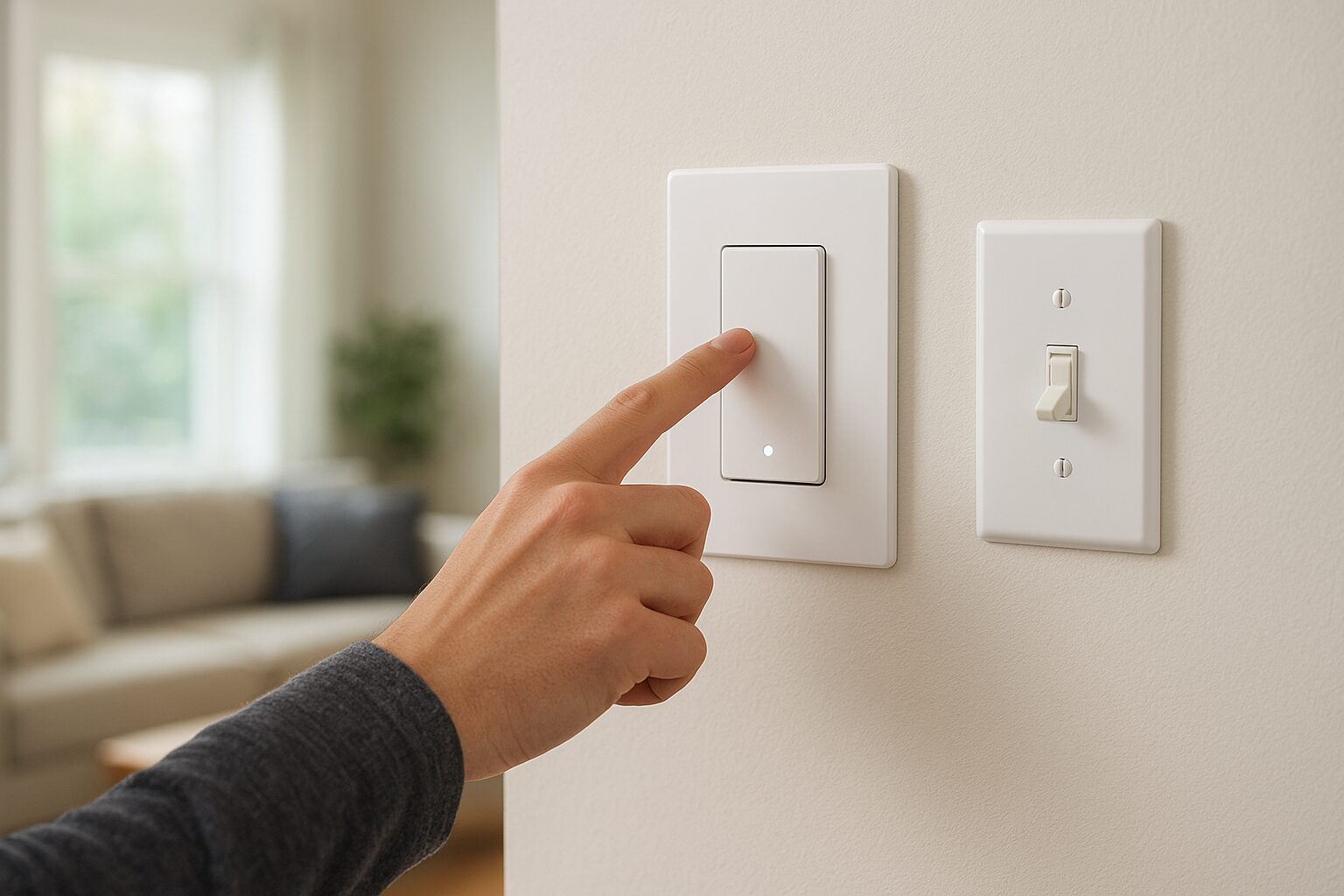Smart home technology has changed the way we live, offering convenience, security, and energy savings like never before. From smart lights to smart thermostats, devices that connect to the internet are making everyday tasks easier. Among these innovations, smart switches play a crucial role in controlling your home’s lighting and electrical devices with just a tap or voice command. If you’ve ever wondered what is smart switch and how it can make your home smarter, this article will walk you through everything you need to know.
If you’re wondering what is smart switch, this article will explain its features, benefits, and how it can transform your home into a smarter, more efficient space.
What Is A Smart Switch
A smart switch is an advanced version of a traditional light switch. While a standard switch simply turns your lights on or off, a smart switch allows you to control your lights and other electrical devices remotely using your smartphone, tablet, or voice assistant.
Traditional Switch vs Smart Switch
| Feature | Traditional Switch | Smart Switch |
|---|---|---|
| Control | Manual | Remote, voice, or app control |
| Scheduling | None | Custom schedules and timers |
| Integration | None | Works with smart home devices |
| Energy Monitoring | No | Yes, tracks energy usage |
Types of Smart Switches
- Wi-Fi Smart Switches – Connect directly to your home Wi-Fi network.
- Bluetooth Smart Switches – Control devices within a limited range via Bluetooth.
- Zigbee Smart Switches – Require a smart hub but offer reliable connectivity and low energy consumption.
- Z-Wave Smart Switches – Similar to Zigbee, ideal for home automation networks.
How Smart Switches Work
Smart switches work by connecting to your home network or smart hub, enabling remote control, automation, and integration with other smart devices.
Connection to Home Network
Most smart switches connect to your Wi-Fi or hub, which allows them to communicate with your smartphone or smart assistant. Once connected, you can control your devices from anywhere, whether you’re at home or away.
Interaction with Smart Home Hubs and Voice Assistants
Smart switches are compatible with popular platforms like Amazon Alexa, Google Home, and Apple HomeKit. This means you can use voice commands such as:
- “Alexa, turn on the living room lights.”
- “Hey Google, dim the bedroom lights to 50%.”
Remote Control via Apps
Smart switch apps let you:
- Turn devices on/off
- Adjust dimmers
- Create schedules
- Monitor energy usage
Automation Features
Smart switches can automate your home using:
- Schedules: Turn lights on or off at specific times.
- Timers: Automatically shut off lights after a set duration.
- Triggers: Connect lights to motion sensors or door sensors for smart automation.
Key Features of Smart Switches
1. Remote Control and Monitoring
Smart switches let you control your devices from anywhere, providing convenience and peace of mind. You can also monitor which devices are on or off in real-time.
2. Energy Efficiency and Usage Tracking
Many smart switches provide energy usage statistics, helping you understand and reduce electricity consumption. This can lead to noticeable savings on your monthly bills.
3. Compatibility with Devices and Systems
Smart switches work with most home electrical devices, including lights, fans, and appliances. Some models even integrate seamlessly with smart home ecosystems, offering centralized control.
4. Safety Features
- Overload protection: Prevents electrical surges
- Child lock: Avoids accidental operation
- Timer-based safety: Ensures devices aren’t left on unnecessarily
Benefits of Using a Smart Switch
1. Convenience and Ease of Control
Imagine turning on your lights from your bed or office without leaving your spot. Smart switches allow you to control your home effortlessly.
2. Energy Savings and Efficiency
By scheduling lights and appliances or monitoring energy use, smart switches help reduce unnecessary electricity consumption.
Graph Suggestion: Include a bar chart showing average energy savings using smart switches vs traditional switches.
3. Enhanced Home Security
Smart switches can simulate occupancy by turning lights on and off at random intervals, deterring potential intruders while you’re away.
4. Integration with Smart Home Ecosystems
Smart switches work in harmony with other smart devices, allowing you to set up complex automation like:
- Lights turning on when doors open
- Fans turning off when temperature drops
- Lights dimming automatically in the evening
How to Install a Smart Switch
Basic Installation Steps
- Turn off the power at the breaker
- Remove your old switch
- Connect the wires to the smart switch terminals
- Attach the switch to the wall box
- Turn on the power and configure the switch using the app
Required Tools and Precautions
- Screwdriver, wire stripper, voltage tester
- Always confirm the power is off
- Follow manufacturer instructions carefully
Tips for Beginners
- Start with a single switch before upgrading multiple rooms
- Ensure your Wi-Fi signal is strong near the switch location
When to Hire a Professional
- Complex wiring situations
- Homes with outdated electrical systems
- Installing switches in high-risk areas like bathrooms or kitchens
Common Issues and Troubleshooting
1. Connectivity Problems
- Ensure Wi-Fi or hub is working properly
- Place the switch within network range
2. Compatibility Challenges
- Check device compatibility with your smart home system before installation
- Use manufacturer-provided apps for setup
3. Tips to Resolve Common Issues
- Restart your smart switch or app
- Reset the switch if it doesn’t respond
- Update firmware regularly
Conclusion
Smart switches are a simple yet powerful way to make your home smarter, safer, and more energy-efficient. Now you know what is smart switch and how it works—from remote control and energy monitoring to automation and voice control.
Upgrade your home with smart switches today and enjoy the convenience and efficiency of modern living.
FAQ
Q1: Can I install a smart switch myself?
A: Yes, if you are comfortable with basic electrical work. Always turn off the breaker and follow the manufacturer instructions. Otherwise, hire a professional.
Q2: Will a smart switch work if my Wi-Fi goes down?
A: Some smart switches operate locally without Wi-Fi, but most features like remote control require an active internet connection.
Q3: Are smart switches compatible with all lights?
A: Most smart switches work with LED, CFL, and incandescent bulbs, but always check compatibility before purchasing.
Q4: Can I control multiple smart switches at once?
A: Yes, using a smart home hub or app, you can control multiple switches simultaneously or automate them together.
Q5: Do smart switches consume electricity when off?
A: They use minimal standby power, usually less than 1 watt, which is negligible compared to the energy savings from automation.
Q6: What’s the difference between a smart plug and a smart switch?
A: A smart plug connects directly to an outlet and controls devices plugged into it, while a smart switch is installed in the wall to control wired fixtures like lights and fans.
Q7: Can smart switches improve home security?
A: Absolutely. You can schedule lights to turn on or off when you’re away, creating the illusion that someone is home and deterring intruders.
Q8: Do smart switches require a smart hub?
A: Some do (like Zigbee or Z-Wave models), while Wi-Fi smart switches connect directly to your home network and don’t need a hub.
Q9: Can I use a smart switch with voice assistants like Alexa or Google Home?
A: Yes, most modern smart switches are compatible with Alexa, Google Assistant, and Apple HomeKit for hands-free voice control.
Q10: How long do smart switches last?
A: With proper installation and use, smart switches can last 10 years or more, depending on the brand and quality.
Disclaimer
This article is for informational purposes only. Always follow local electrical codes and manufacturer instructions when installing smart switches. If you are unsure about electrical work, consult a licensed professional.



